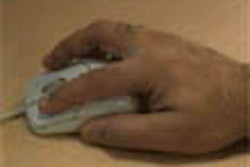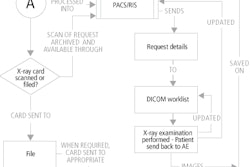ORLANDO, FL - Radiologists are facing a tsunami-size wave of imaging data that threatens to crash onto the shores of their practices. Whether they will sink or swim is anyone's guess, but it will depend in large measure on their willingness to adapt to new ways of managing, viewing, and reporting diagnostic imaging information, according to a group from the Society for Computer Applications in Radiology (SCAR).
"There are a couple of convergent factors that are exacerbating the information overload in radiology: an increased workload due to a greater demand for imaging services by a growing patient population, and a decreased number of radiologists and radiologic technologists to provide those imaging services. We need to increase the efficiency of diagnostic interpretation without sacrificing quality," said Dr. Eliot Siegel.
Siegel, professor and vice chairman of information systems at the University of Maryland School of Medicine in Baltimore, discussed imaging interpretation methodologies for large-volume datasets as part of a presentation on SCAR’s Transforming the Radiological Interpretation Process (TRIP) initiative at the Healthcare Information and Management Systems Society (HIMSS) conference on Monday.
TRIP is designed to spearhead research, education, and discovery of approaches to the problems of information and image data overload, according to fellow presenter Richard Morin, Ph.D., a physicist with the Mayo Clinic in Jacksonville, FL.
Image interpretation evolution
There are five phases of image interpretation that have occurred in radiology, according to Siegel. These are:
- Film-based reading;
- Static soft-copy reading (which seeks to mimic the film-reading experience as much as possible on a workstation);
- Dynamic soft-copy reading in which the radiologist utilizes image processing and enhancement tools such as window-leveling and edge enhancement;
- Stack mode, in which images, usually in the axial plane, are rapidly viewed from beginning to end of the acquisition area; and
- Volumetric navigation, multiplanar reformatting (MPR), and 3-D imaging.
The current method of dealing with large-volume image datasets is to view them in stack mode. However, according to Siegel, this method is rapidly becoming too limiting.
"At the Baltimore VA Medical Center we’ve found that the stack-mode reading approach is inadequate for reviewing the 300 to 500 images acquired during a routine CT of the chest, abdomen, or pelvis, and is certainly not adequate for the 1,600 to 2,000 images generated during a CT angiography runoff study," he said.
This is also the case for complicated MR procedures such as functional studies, and even general radiography studies have become more complex, Siegel said. To cope with the volume of images generated by a multidetector CT scanner acquiring images with collimation from 0.6 mm-1 mm, radiologists are adopting tactics such as reconstructing the images sent to the PACS network by combining the data into thicker sections, such as with 5-mm or 8-mm slices, Siegel said.
Although this workaround reduces the number of images sent to a PACS workstation, rendering of the images takes time away from the technologist or radiologist who must reconstruct the new dataset. In addition to the loss of productivity, there are burdens to the system in terms of archive, network, and workstation memory space for these datasets.
Most important, according to Siegel, radiologists are limited to reviewing routine images in the axial plane at a pre-determined, usually relatively thick plane of section -- negating the added value and power of the new-generation scanners.
"Radiologists should have the flexibility from case to case to determine whether the images should be reviewed in the sagittal or coronal or any oblique plane in any slice, and with volumetric navigation we can do that," he said.
With volumetric navigation, MPR, and 3-D imaging, the process of image review can be separated from the manner in which images were acquired and reconstructed, Siegel said. The use of these tools, along with isotropic, thin-section imaging, provides the radiologist the freedom to access the patient data in a multiple number of views.
The 22-hour workday
A new methodology for viewing and interpreting images, such as volumetric navigation, is critical if radiology is to meet the demands of its consumers. According to Morin, a typical radiologist in 1994 was viewing approximately 1,500 images a day. By 2002, that volume had increased to 16,000 images per day.
If imaging volume continues to increase at the same pace, by 2006, a radiologist will be expected to view up to 60,000 images on a daily basis, he said.
"To put this figure into context, if only one second of viewing is allowed for each image, the average radiologist will be working a 22.2-hour day," Morin noted.
Clear and direct
Dr. Bruce Reiner, also a professor at the University of Maryland School of Medicine and a private-practice radiologist, advocated the use of four pieces of currently available technology for increasing and streamlining radiologist productivity.
A computerized physician order entry (CPOE) system will reduce referring-physician error and provide an automated scheduling tool to balance workload in an imaging practice, he said.
Computer-aided detection (CAD) applications, such as those currently available for mammography and being developed for thoracic and cardiology imaging, have been demonstrated to improve radiologists' ability to detect small (< 5 mm) lesions and masses that may otherwise be missed, Reiner said.
Speech recognition software, combined with structured reporting, are the other two pieces of the report management grand slam that Reiner recommends.
"Referring physicians hate ambiguity in the reports they receive from radiologists," Reiner said. "With structured reporting, you’re reporting your impressions in clean, clear, and precise language, without the ambiguity that drives the clinicians crazy."
Finally, by combining images, speech recognition, structured-reporting tools, and instant-messaging capabilities, the radiologist has the ability to provide a multimedia, content-driven report to the referring clinician that takes less time and provides more information than traditional reporting methodologies, he said.
By Jonathan S. BatchelorAuntMinnie.com staff writer
February 24, 2004
Related Reading
SCAR tackles image data glut at 2003 show, October 7, 2003
Volumetric image review offers potential, challenges, June 27, 2003
SCAR debuts TRIP initiative, May 12, 2003
Copyright © 2004 AuntMinnie.com


















